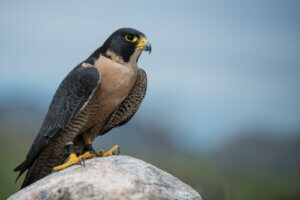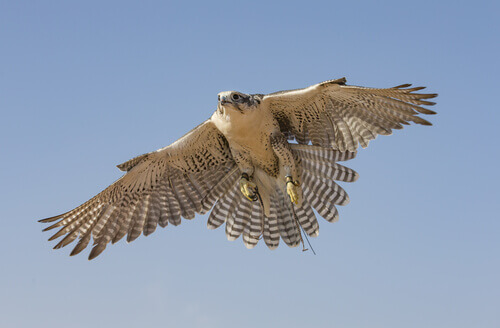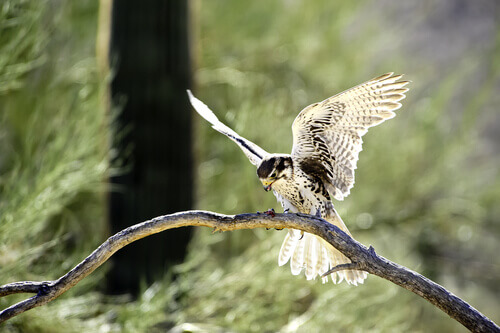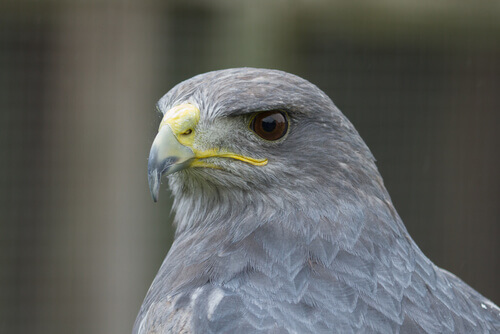5 Species of Falcon

They’re known as kestrels or hobbies, and the whole family has fine wings that allow them to fly very fast. In this article, we’ll tell you about some of falcon species that inhabit the planet and fly through the skies.
What species of falcon are there?
In total, we could talk about almost 40 species among peregrines, kestrels, and hobbies. These birds have large eyes, small beaks and, like all birds of prey, thick feet enabling them to get food during flight. In addition, they can fly very fast and at great heights due to the shape of their feathers and tails. Among them we highlight the following:
1. Peregrine falcon
It’s undoubtedly the most famous of the falcons and also the fastest: it can reach 300 km/h (186 mi/h) in a dive and more than 100 km/h (62 mi/h) in straight flight. The peregrine falcon is similar in size to the raven, and the females are larger than the males.

The habitat of this bird is really vast, as it can be found in the tundra, as well as in forests, polar regions, and rocky and coastal areas. It bears this name due to its migratory habits, and is easily recognizable by its black and gray feathers, as well as its yellow legs and beak edge. The chest, as well as the contour around the large black eyes, are white.
It feeds on medium-sized birds and sometimes small rodents, which it hunts at dawn and before dusk. As for reproduction, they form monogamous pairs for life and always use the same nest, to which they return year after year, and which allows them to lay about four eggs.
2. Prairie falcon
Even if its scientific name —Falco mexicanus— indicates that it lives in Mexico (Oaxaca and Mexico City), this isn’t the only country it inhabits. It’s also found in Canada (Alberta, British Columbia and Saskatchewan) and the United States of America (California and other western states).
It prefers arid or semi-arid regions with low or dense vegetation, and lives no more than 2,300 m (7550 ft) above sea level.

As to its appearance, it’s very similar to the peregrine falcon. We can distinguish it from the other species due to its light-colored plumage. It can measure about 45 cm (18 in) in length with a 1 meter (3 feet) wingspan, and weighs about 750 g (1.65 lb).
This species of falcon nests in rocky outcrops and crevices, and in caves. It doesn’t cover its “home” with any kind of material, and every year the couple returns to the same place to lay up to four eggs. It hunts while flying and its favorite prey are hares.
3. Black falcon
This is another species of falcon we can highlight. In this case, it’s endemic to Australia, specifically to areas with vegetation that aren’t too high: grasslands and forests in the north of the country.

The black falcon, as its name suggests, has completely dark plumage that gets a little lighter at the base of the beak. Females are about 10 cm (4 in) taller and about 100 g (4 oz) heavier than males.
They fly very fast thanks to their pointed wings, which can measure 1 m (3 ft) when fully spread. They feed on small birds, lizards, hares and partridges.
4. Gray falcon
The grey falcon is another species that can only be found in Australia, where it’s quite difficult to see. Not much is known about this bird, which is easily mistaken for other species in this family, such as the brown falcon.

Its main habitat is made up of forests, scrublands and arid grasslands, with rainfall of less than 500 mm (20 in) per year. It’s in a vulnerable state because of the reduction of its habitat due to agriculture and grazing.
5. Lanner falcon: an African species of falcon
This falcon is native to Africa, but it also lives in Europe, the Caucasus and the Arabian Peninsula. It’s quite sedentary, but some pairs move away during the mating season. They choose rocky outcrops on the cliffs to make their nests.

The lanner falcon is robust, measuring about 45 cm (18 in) long. Its plumage is darker on the back, while the belly has brown and white “spots”. The legs are yellow with black nails, and the beak is pale.
It feeds on winged termites, birds, and fruit bats, which it catches in flight. It also consumes lizards and rats, which it captures at low altitudes and at high speed. Even if it’s quite silent when hunting, it can be quite vocal while nesting and mating.
They’re known as kestrels or hobbies, and the whole family has fine wings that allow them to fly very fast. In this article, we’ll tell you about some of falcon species that inhabit the planet and fly through the skies.
What species of falcon are there?
In total, we could talk about almost 40 species among peregrines, kestrels, and hobbies. These birds have large eyes, small beaks and, like all birds of prey, thick feet enabling them to get food during flight. In addition, they can fly very fast and at great heights due to the shape of their feathers and tails. Among them we highlight the following:
1. Peregrine falcon
It’s undoubtedly the most famous of the falcons and also the fastest: it can reach 300 km/h (186 mi/h) in a dive and more than 100 km/h (62 mi/h) in straight flight. The peregrine falcon is similar in size to the raven, and the females are larger than the males.

The habitat of this bird is really vast, as it can be found in the tundra, as well as in forests, polar regions, and rocky and coastal areas. It bears this name due to its migratory habits, and is easily recognizable by its black and gray feathers, as well as its yellow legs and beak edge. The chest, as well as the contour around the large black eyes, are white.
It feeds on medium-sized birds and sometimes small rodents, which it hunts at dawn and before dusk. As for reproduction, they form monogamous pairs for life and always use the same nest, to which they return year after year, and which allows them to lay about four eggs.
2. Prairie falcon
Even if its scientific name —Falco mexicanus— indicates that it lives in Mexico (Oaxaca and Mexico City), this isn’t the only country it inhabits. It’s also found in Canada (Alberta, British Columbia and Saskatchewan) and the United States of America (California and other western states).
It prefers arid or semi-arid regions with low or dense vegetation, and lives no more than 2,300 m (7550 ft) above sea level.

As to its appearance, it’s very similar to the peregrine falcon. We can distinguish it from the other species due to its light-colored plumage. It can measure about 45 cm (18 in) in length with a 1 meter (3 feet) wingspan, and weighs about 750 g (1.65 lb).
This species of falcon nests in rocky outcrops and crevices, and in caves. It doesn’t cover its “home” with any kind of material, and every year the couple returns to the same place to lay up to four eggs. It hunts while flying and its favorite prey are hares.
3. Black falcon
This is another species of falcon we can highlight. In this case, it’s endemic to Australia, specifically to areas with vegetation that aren’t too high: grasslands and forests in the north of the country.

The black falcon, as its name suggests, has completely dark plumage that gets a little lighter at the base of the beak. Females are about 10 cm (4 in) taller and about 100 g (4 oz) heavier than males.
They fly very fast thanks to their pointed wings, which can measure 1 m (3 ft) when fully spread. They feed on small birds, lizards, hares and partridges.
4. Gray falcon
The grey falcon is another species that can only be found in Australia, where it’s quite difficult to see. Not much is known about this bird, which is easily mistaken for other species in this family, such as the brown falcon.

Its main habitat is made up of forests, scrublands and arid grasslands, with rainfall of less than 500 mm (20 in) per year. It’s in a vulnerable state because of the reduction of its habitat due to agriculture and grazing.
5. Lanner falcon: an African species of falcon
This falcon is native to Africa, but it also lives in Europe, the Caucasus and the Arabian Peninsula. It’s quite sedentary, but some pairs move away during the mating season. They choose rocky outcrops on the cliffs to make their nests.

The lanner falcon is robust, measuring about 45 cm (18 in) long. Its plumage is darker on the back, while the belly has brown and white “spots”. The legs are yellow with black nails, and the beak is pale.
It feeds on winged termites, birds, and fruit bats, which it catches in flight. It also consumes lizards and rats, which it captures at low altitudes and at high speed. Even if it’s quite silent when hunting, it can be quite vocal while nesting and mating.
This text is provided for informational purposes only and does not replace consultation with a professional. If in doubt, consult your specialist.








